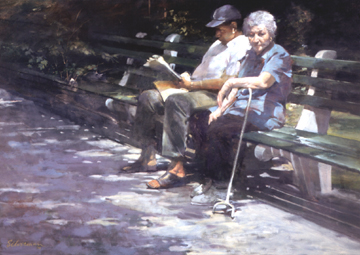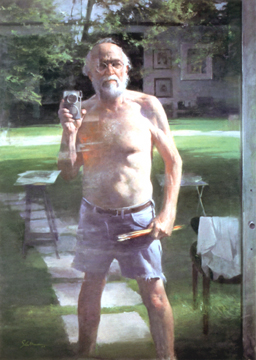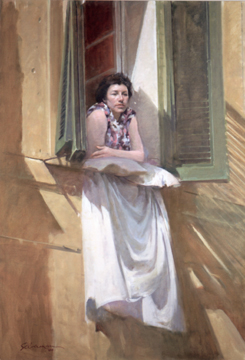
(845) 246-6944 ·
info@ArtTimesJournal.com
Burton
Silverman:
(Photos Courtesy Gallery Henoch)
By
RAYMOND J. STEINER
ART TIMES December, 2004
|
|
A
STEADFAST REALIST, Burton Silverman has committed his career and reputation
to the enduring tradition of figurative painting — a decision that
one can only laud when in the presence of his work. Some 28 recent paintings
comprise the exhibit, all but one, “Near Mahopac,” a landscape
from somewhere along the Taconic Parkway, depicting one or more figures.
Silverman
usually works large, the effect of the combined impact of his paintings
almost always overwhelming — not merely due to their size, however,
but for their absolute fidelity to the “real” world which,
when we enter a room full of his paintings, we seem to be viewing through
a series of ‘windows’.
Realism,
taken to extremes, can often come across to the viewer as “kitschy”,
a bit over the top in “hitting us over the head” with tedious
and overdone fussiness. Not so with a Burton Silverman painting.
Since
there is but one, let me begin with the landscape, “Near Mahopac.”
Though obviously a scene that we might see any late summer or early autumn
afternoon we are driving north on the Taconic, Silverman’s rendition
with its softly suggested mountains in the background and its nearer grouping
of trees smokily modulated in soft-edge stroke, counterbalance the sharply
delineated outcropping of gray rock that serves as the focal point of
the painting. Softened by both shade and sunlight, even here, however,
we do not find any harsh touch that might detract from the almost dreamy
atmosphere that permeates the view. It is, in brief, “of a piece”
— thoughtfully composed and skillfully handled, the only contrapuntal
“heaviness”, one of light and shade rather than of jarring
subject matter. Drama — if it can be properly said to be even found
in a painting — comes from within the viewer — the landscape
a near perfect blending of picture and viewer.
|
|
As
dexterously as Silverman may handle landscape — and he can dash
off lovely little gems of sun-dappled tree or park path that serve as
backdrop foils for his main subjects — his especial forte is the
painting of the figure. A humanist, it is above all in depicting the human
form — and especially the face — that Silverman shows us his
true mastery of his medium. Though he is equally adept in painting the
male, he appears to prefer the opposite sex and is particularly sensitive
to the female visage, his limning of feminine features universally handled
with delicacy and insight. We see over and over again — in paintings
such as “Claire”, “Woman in a Black Hat”, “Nail
Care”, “Park Bench”, “Museum”, “Hanging
Out”, “Summer of ‘82”, to name but a few —
more than just a face, but the hints of a deeper humanity, an entire personality
“writ large” in not only the facial delineations, but also
in the gaze of the eye, the tilt of the head, the cant of the neck and
shoulders — physical, idiosyncratic traits that have been built
up and that have settled into habitual attitudes and postures over a lifetime
of confronting the world. Though captured “in a moment”, Silverman’s
portraits are mini-biographies, visual journals that, if properly read,
reveal the extended novel that every human carries within his or her soul.
There
are two self-portraits in this exhibit— “Survivor” and
“Self Portrait with Scarf” — that, for this viewer,
firmly places Burton Silverman amongst the masters. Already lauded for
his paintings of portraits (he is the recipient of many awards, among
which is the recent John Singer Sargent Medal awarded by the American
Society of Portrait Artists in 1998), his work has been sought after by
a host of notables and has appeared on the covers and pages of such publications
as Time Magazine and the New Yorker.
That he is able to capture likenesses, therefore, is well documented
and needs no further elaboration from me.
Getting
the likeness of a sitter, however, is not quite the same as getting a
likeness of oneself — a fact well documented in the annals of art
history. It is an old observation that the skill of painters of the figure
can always be “found out” by looking at how they paint the
hand. For the portrait painter, it is always how they portray their own
faces that tells the tale. Burton Silverman is one of the very few
portrait artists that I know who is able to straightforwardly portray
himself. To sit before a blank canvas and a mirror simultaneously is a
trick that not many portraitists — no matter how skilled —
have ever successfully mastered. It takes a state of mind that is both
objective and subjective at one and the same time and, at least in my
experience, I have found few artists able to successfully pull it off.
|
|
In
both his “Survivor” — a large (56 X 40 inches), nearly
full-scale portrait (the picture cuts Silverman off just above the ankles),
as well as in his “Self Portrait with Scarf” — (a more
modest 16 x 20 inch upper-torso ‘shot’) — Silverman
manages the feat with aplomb and near-perfect brilliance. These self-portraits
look like Silverman the man — neither idealized nor falsely
modest ‘put-downs’ of his body or visage that one can only
describe as “photographic” renditions of himself.
One
must be careful when speaking of “photographic” renditions
since these (or for that matter, any of Silverman’s paintings)
are not by any stretch of the imagination examples of what is commonly
referred to as “photo-realism” — an artform that is
more often than not a form of virtuostic gimmickry than of painterly brushwork
— and let there be no doubt that Silverman is first and foremost
a painter. At another instance [Critique, ART TIMES April
2002], I referred to Silverman in terms of the old-time tag of being an
“artist’s artist” — that is, a man not only in
command of his materials, but a man held in high esteem by his peers (few
may they be). In short, he is an artist who knows his craft and who eschews
the shortcut of well-learned formulae.
In
the end, it is of course that ever-so-difficult balance of objectivity
and subjectivity that marks the master and allows for the illusive flashes
of genius that can appear in a work — and Silverman, in attaining
that balance, comes as close to earning a claim to it as any in the field
today.
*“Burton
Silverman: Recent Paintings” (thru Dec 4): Gallery Henoch, 555 W.
25th St., NYC (917) 305-0003.


